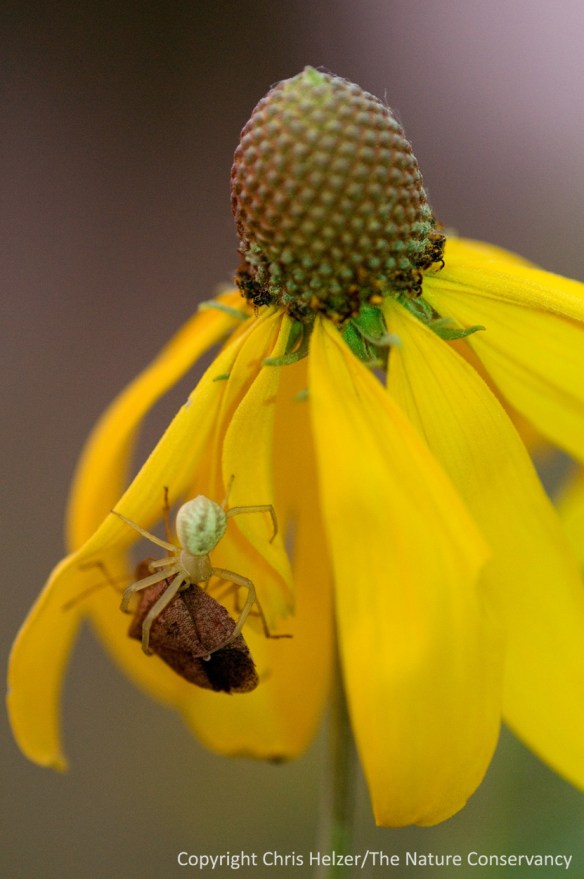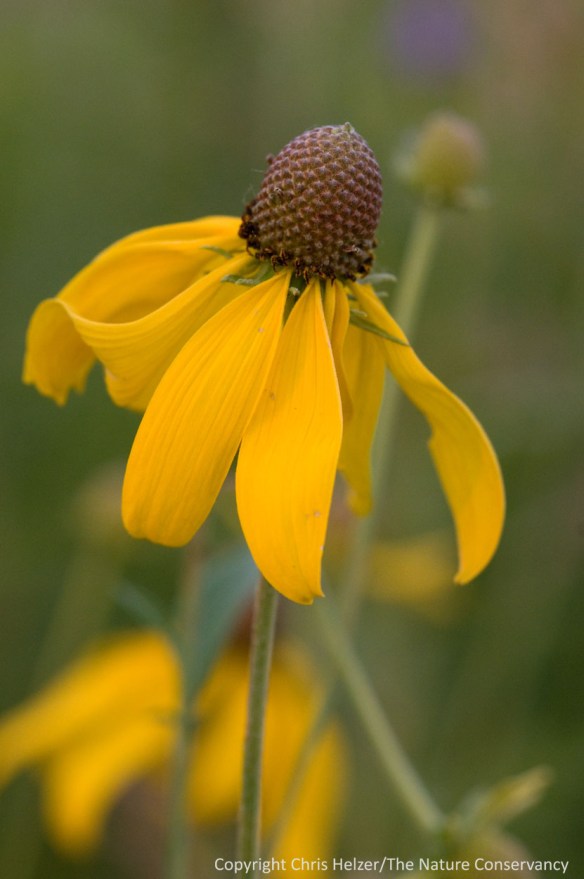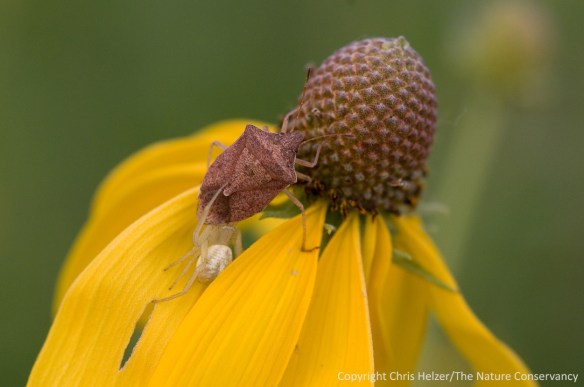Last Friday, I was at my in-laws’ farm in eastern Nebraska (Sarpy County). Toward evening, the hot, sunny, windy day transformed into a cloudy evening with light winds. I stepped outside to look over the little patch of restored (reconstructed) prairie in their front yard. The sun was going down behind the clouds, but there was a small gap of clear sky between the clouds and the horizon. Foreseeing a small window of time with some good photography light, I went back to the house and grabbed my camera and tripod.
As I came back out of the house, the sun was just coming out from beneath the cloud bank. There were only a few places in the little prairie that were being hit by the low-angled light, and the best color in the prairie seemed to be the gray-headed coneflowers that were just starting to bloom.
I chose a flower and set up the tripod to photograph it. After only a couple of shots, a stink bug flew in and landed on the flower. Just as I began focusing on the stink bug to see if he’d pose for me, a crab spider suddenly squirted out from inside the canopy of coneflower petals and grabbed the startled stinkbug.
Initially, it looked like the spider was having a hard time finding a place to bite the stink bug through its tough carapace, and for a minute or so, the bug was pulling the spider around the flower and it looked like an even chance that it would escape. However, the spider eventually latched onto the bug near its rear end and hung on tight. The stink bug continued to crawl around the flower, hauling its spider cargo with it, but over the next few minutes, the pauses between movements became longer and longer.

In this photos, you can better see where the spider sunk its fangs into the bug (soft underbelly?) Eventually, the stink bug stopped moving altogether, and it was game over.
As the sun went completely below the horizon, the stink bug finally stopped moving altogether. After a few more minutes, the crab spider let go and rotated the bug into a new position within its grasp – apparently to feed? I’ve watched crab spiders attack and feed quite a few times before, but don’t remember seeing one changes positions to feed – they usually seem to just feed through the same initial fang holes they make to kill their prey.

A few minutes after the stink bug gave up the ghost, the spider flipped it around in its grasp. This photo was taken several minutes after the sun had gone down.
Right after the above photo was taken, the wind kicked up, and it felt like a storm was coming, so I left the spider to its meal and went inside – feeling grateful for the opportunity I’d just been given. Who needs TV??
Photography Notes
For those of you who are photographers, you might be interested in a couple things about this photo series. As I said earlier, the sun was low in the sky. It was a nice red color, providing great warm light on the flowers and bugs. However, the light intensity was low, and there was a slight breeze that was moving all the plants back and forth a little. I set my camera’s ISO on 500 to allow me to take the photos at between 1/25 and 1/50 of a second, which was sufficient to stop the motion. The trickiest part was timing the shot between wind gusts so that the eyes of the stink bug were in focus (or, a few times, the eyes of the spider). I shot about 50 photos over 10 minutes or so, and about 15 turned out sharp.
The last photo above was the trickiest because the sun had been down for a few minutes, and there was no direct light at all. It was too dark to stop the wind-driven motion of the flower, so my only chance at getting the last shot – which was too good to miss – was to use flash. Unfortunately, I don’t own a flash other than the pop-up flash on my Nikon 300s camera. So, I popped up the flash and set the camera on Program. Having tried to use the flash for macrophotography before, I knew that the flash alone was too bright for close-up shots, so I improvised. I pulled my arm out of one sleeve of my t-shirt and wrapped the shirt sleeve over the flash and then took the shot. The shirt acted to diffuse the flash’s light but still allowed enough light for the photo to work. It took a couple tries to get the focus right (the stupid flower kept moving!) but it eventually worked. I’d never tried this little trick before, but now I might have to throw an old t-shirt into my camera bag for similar future emergencies! (or maybe just the sleeve…)




There is a handy little translucent flash cover that serves just that purpose, pocket sized. But I generally use a piece of paper :D
You’re right about TV – nature is so much more interesting.
Pingback: Coneflower Surprise | The Prairie Ecologist | Stink Bugs 411
Very nice series, would love to get some action shots like these myself.
Great capture!
Chris; An amazing sequence – I guess stink bugs should be careful what they grab onto. Thanks, Mark.
Surprise
Yesterday I was checking on prairie near Denison Iowa. This seven acre prairie was once a hay field for my Grandfather in early part of the 20 century. The only road to the prairie are unimproved dirt roads. As I was driving down the road I saw a young badger running down the road. I came to a complete stop garbed my camera and do my well should say our surprise to badger was sitting alongside my car looking at me. She did not wait long to climb up a bank and dive into a well hidden den. I few second later a nose appeared at the entrance of the den but quickly disappeared when the nose saw my camera pointing it direction. I waited for the nose to appear again but was greeted by dirt flying out of the den. In a few seconds the entrance to the den was completely blocked. Never got a picture. Glenn Pollock
That’s a great surprise! Don’t let the camera get in the way of a great experience… Photo or not, that’s pretty nice. I don’t have a badger photo either…
Nice series Chris. How about a piece of translucent plastic? I think it would be less troublesome than a t shirt and can be used for a very long time. How high can you set your ASA on the 300? That can make some difference in those last light shots.
Ernie
Thanks Ernie. I think the plastic might work well. I tested a small piece of linen attached with a rubber band the other evening, and it seemed to work great – and fits easily into my camera bag. I’ll go with that for a while… I don’t even know what the top ISO is on the D300s. High enough! Yeah, that’d be an option too, although the grain would eventually become an issue, and it seems like there’s a big loss of contrast in really low light that the diffused flash can help compensate for.
Pingback: Photo of the Week | The Prairie Ecologist
Hwy 50 in Sarpy co from Hwy 370 to Springfield has a lot of grayheads and are just starting to bloom. Last year they were pretty impressive when in full bloom. The grayheads in my little 2nd year prairie are just starting to bloom and some are 5′ tall. The only thing taller are the nettles :(
This was a very interesting series! I love the technique you said you used at the end. Might have to try it sometime. :)